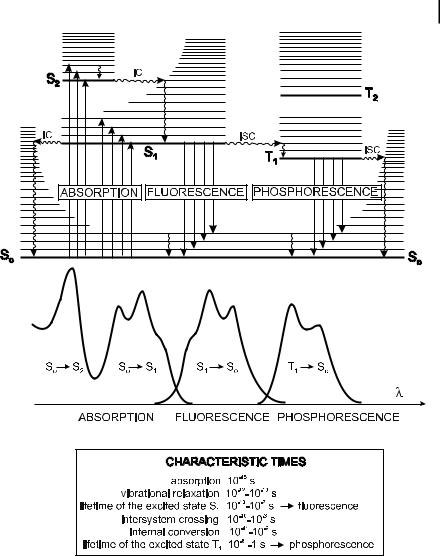
Molecular Fluorescence
.pdf
3.1 Radiative and non-radiative transitions between electronic states 35
Fig. 3.1. Perrin–Jablonski diagram and illustration of the relative positions of absorption, fluorescence and phosphorescence spectra.
displacement of the nuclei according to the Franck–Condon principle; see Chapter 2).
The vertical arrows corresponding to absorption start from the 0 (lowest) vibrational energy level of S0 because the majority of molecules are in this level at room temperature, as shown in Box 3.1. Absorption of a photon can bring a molecule to one of the vibrational levels of S1; S2; . . . : The subsequent possible de-excitation processes will now be examined.

36 3 Characteristics of fluorescence emission
Box 3.1 Relative populations of molecules in the vibrational energy levels according to the Boltzmann Law
For some aromatic hydrocarbons such as naphthalene, anthracene and perylene, the absorption and fluorescence spectra exhibit vibrational bands. The energy spacing between the vibrational levels and the Franck–Condon factors (see Chapter 2) that determine the relative intensities of the vibronic bands are similar in S0 and S1 so that the emission spectrum often appears to be symmetrical to the absorption spectrum (‘mirror image’ rule), as illustrated in Figure B3.1.
The ratio of the numbers of molecules N1 and N0 in the 1 and 0 vibrational levels of energy E1 and E0, respectively, is given by the Boltzmann Law:
N1=N0 ¼ exp½ ðE1 E0Þ=kT&
where k is the Boltzmann constant (k ¼ 1:3807 10 23 J K 1) and T is the absolute temperature.
For instance, the absorption and emission spectra of anthracene show a wavenumber spacing of about 1400 cm 1, i.e. an energy spacing of 2:8 10 20 J, between the 0 and 1 vibrational levels. In this case, the ratio N1=N0 at room temperature (298 K) is about 0.001.
Fig. B3.1. Illustration of the vibrational bands in the absorption and fluorescence spectra of aromatic hydrocarbons. Broadening of the bands will be explained in Section 3.5.1.

3.1 Radiative and non-radiative transitions between electronic states 37
However, it should be noted that most fluorescent molecules exhibit broad and structureless absorption and emission bands, which means that each electronic state consists of an almost continuous manifold of vibrational levels. If the energy di erence between the 0 and 1 vibrational levels of S0 (and S1) is, for instance, only about 500 cm 1, the ratio N1=N0 becomes about 0.09. Consequently, excitation can then occur from a vibrationally excited level of the S0 state. This explains why the absorption spectrum can partially overlap the fluorescence spectrum (see Section 3.1.2).
Finally, in all cases, the energy gap between S0 and S1 is of course much larger than between the vibrational levels, so the probability of finding a molecule in S1 at room temperature as a result of thermal energy is nearly zero (ES1 ES0 A4 10 19 J, compared with kT A4 10 21 J.)
3.1.1
Internal conversion
Internal conversion is a non-radiative transition between two electronic states of the same spin multiplicity. In solution, this process is followed by a vibrational relaxation towards the lowest vibrational level of the final electronic state. The excess vibrational energy can be indeed transferred to the solvent during collisions of the excited molecule with the surrounding solvent molecules.
When a molecule is excited to an energy level higher than the lowest vibrational level of the first electronic state, vibrational relaxation (and internal conversion if the singlet excited state is higher than S1) leads the excited molecule towards the 0 vibrational level of the S1 singlet state with a time-scale of 10 13 –10 11 s.
From S1, internal conversion to S0 is possible but is less e cient than conversion from S2 to S1, because of the much larger energy gap between S1 and S01). Therefore, internal conversion from S1 to S0 can compete with emission of photons (fluorescence) and intersystem crossing to the triplet state from which emission of photons (phosphorescence) can possibly be observed.
3.1.2
Fluorescence
Emission of photons accompanying the S1 ! S0 relaxation is called fluorescence. It should be emphasized that, apart from a few exceptions2), fluorescence emission occurs from S1 and therefore its characteristics (except polarization) do not depend
1) The smaller the energy gap between the |
2) For instance, emission from S2 in the case of |
initial and final electronic states, the larger |
azulene; simultaneous emission from S1 and |
the e ciency of internal conversion. |
S2 in the case of indole in some solvents. |

38 3 Characteristics of fluorescence emission
on the excitation wavelength (provided of course that only one species exists in the ground state).
The 0–0 transition is usually the same for absorption and fluorescence. However, the fluorescence spectrum is located at higher wavelengths (lower energy) than the absorption spectrum because of the energy loss in the excited state due to vibrational relaxation (Figure 3.1). According to the Stokes Rule (an empirical observation pre-dating the Perrin–Jablonski diagram), the wavelength of a fluorescence emission should always be higher than that of absorption. However in most cases, the absorption spectrum partly overlaps the fluorescence spectrum, i.e. a fraction of light is emitted at shorter wavelengths than the absorbed light. Such an observation seems to be, at first sight, in contradiction to the principle of energy conservation. However, such an ‘energy defect’ is compensated for (as stated by Einstein for the first time) by the fact that at room temperature, a small fraction of molecules is in a vibrational level higher than level 0 (distribution among the energy levels fulfilling the Boltzmann Law; see Box 3.1) in the ground state as well as in the excited state. At low temperature, this departure from the Stokes Law should disappear.
In general, the di erences between the vibrational levels are similar in the ground and excited states, so that the fluorescence spectrum often resembles the first absorption band (‘mirror image’ rule). The gap (expressed in wavenumbers) between the maximum of the first absorption band and the maximum of fluorescence is called the Stokes shift.
It should be noted that emission of a photon is as fast as absorption of a photon (A10 15 s). However, excited molecules stay in the S1 state for a certain time (a few tens of picoseconds to a few hundreds of nanoseconds, depending on the type of molecule and the medium) before emitting a photon or undergoing other deexcitation processes (internal conversion, intersystem crossing). Thus, after excitation of a population of molecules by a very short pulse of light, the fluorescence intensity decreases exponentially with a characteristic time, reflecting the average lifetime of the molecules in the S1 excited state (excited-state lifetime; see Section 3.2.1). Such an intensity decay is formally comparable with a radioactive decay that is also exponential, with a characteristic time, called the radioactive period, reflecting the average lifetime of a radioelement before disintegration.
The emission of fluorescence photons just described is a spontaneous process. Under certain conditions, stimulated emission can occur (e.g. dye lasers) (see Box 3.2).
3.1.3
Intersystem crossing and subsequent processes
A third possible de-excitation process from S1 is intersystem crossing toward the T1 triplet state followed by other processes, according to Scheme 3.1.

3.1 Radiative and non-radiative transitions between electronic states 39
Box 3.2 Spontaneous and stimulated emissions
The Einstein coe cients characterize the probability of transition of a molecule between two energy levels E1 and E2 (Scheme B3.2). B12 is the induced absorption coe cient (see Chapter 2), B21 is the induced emission coe cient and A21 is the spontaneous emission coe cient. The emission-induced process E2 ! E1 occurs at exactly the same rate as the absorption-induced process E1 ! E2, so that
B12 ¼ B21.
Scheme B3.2
The number of molecules in states 1 and 2 is N1 and N2, respectively. These numbers must satisfy the Boltzmann Law:
N1 ¼ exp½ ðE1 E2Þ=kT& ¼ expðþhn=kTÞ
N2
where h is Planck’s constant.
The rate of absorption from state 1 to state 2 is N1B12rðnÞ, where rðnÞ is the energy density incident on the sample at frequency n. The rate of emission from state 2 to state 1 is N2½A21 þ B21rðnÞ&. At equilibrium, these two rates are equal, hence
N1 |
|
B21rðnÞ þ A21 |
|
1 |
|
A21 |
|
N2 |
¼ |
B12rðnÞ |
¼ |
þ B12rðnÞ |
|||
|
|||||||
The radiation density rðnÞ is given by Planck’s black body radiation law:
8phn3
rðnÞ ¼ c3 expðþhn=kTÞ 1
The three equations above lead to
8phn3
A21 ¼ c3 B21
Note that the ratio A21=B21 is proportional to the cube of the frequency. For this reason, while in the visible region essentially all emission is spontaneous

40 3 Characteristics of fluorescence emission
for the usual radiation levels, the same is not true for longer wavelengths (e.g. radiofrequencies), where spontaneous emission is negligible.
The condition for observing induced emission is that the population of the first singlet state S1 is larger than that of S0, which is far from the case at room temperature because of the Boltzmann distribution (see above). An inversion of population (i.e. NS1 > NS0) is thus required. For a four-level system inversion can be achieved using optical pumping by an intense light source (flash lamps or lasers); dye lasers work in this way. Alternatively, electrical discharge in a gas (gas lasers, copper vapor lasers) can be used.
In contrast to spontaneous emission, induced emission (also called stimulated emission) is coherent, i.e. all emitted photons have the same physical characteristics – they have the same direction, the same phase and the same polarization. These properties are characteristic of laser emission (L.A.S.E.R. ¼ Light Amplification by Stimulated Emission of Radiation). The term induced emission comes from the fact that de-excitation is triggered by the interaction of an incident photon with an excited atom or molecule, which induces emission of photons having the same characteristics as those of the incident photon.
Scheme 3.1

3.1 Radiative and non-radiative transitions between electronic states 41
3.1.3.1 Intersystem crossing
Intersystem crossing3) is a non-radiative transition between two isoenergetic vibrational levels belonging to electronic states of di erent multiplicities. For example, an excited molecule in the 0 vibrational level of the S1 state can move to the isoenergetic vibrational level of the Tn triplet state; then vibrational relaxation brings it into the lowest vibrational level of T1. Intersystem crossing may be fast enough (10 7 –10 9 s) to compete with other pathways of de-excitation from S1 (fluorescence and internal conversion S1 ! S0).
Crossing between states of di erent multiplicity is in principle forbidden, but spin–orbit coupling (i.e. coupling between the orbital magnetic moment and the spin magnetic moment) (see Chapter 2) can be large enough to make it possible. The probability of intersystem crossing depends on the singlet and triplet states involved. If the transition S0 ! S1 is of n ! p type for instance, intersystem crossing is often e cient. It should also be noted that the presence of heavy atoms (i.e. whose atomic number is large, for example Br, Pb) increases spin–orbit coupling and thus favors intersystem crossing.
3.1.3.2 Phosphorescence versus non-radiative de-excitation
In solution at room temperature, non-radiative de-excitation from the triplet state T1, is predominant over radiative de-excitation called phosphorescence. In fact, the transition T1 ! S0 is forbidden (but it can be observed because of spin–orbit coupling), and the radiative rate constant is thus very low. During such a slow process, the numerous collisions with solvent molecules favor intersystem crossing and vibrational relaxation in S0.
On the contrary, at low temperatures and/or in a rigid medium, phosphorescence can be observed. The lifetime of the triplet state may, under these conditions, be long enough to observe phosphorescence on a time-scale up to seconds, even minutes or more.
The phosphorescence spectrum is located at wavelengths higher than the fluorescence spectrum (Figure 3.1) because the energy of the lowest vibrational level of the triplet state T1 is lower than that of the singlet state S1.
3.1.3.3 Delayed fluorescence
Thermally activated delayed fluorescence Reverse intersystem crossing T1 ! S1 can occur when the energy di erence between S1 and T1 is small and when the lifetime of T1 is long enough. This results in emission with the same spectral distribution as normal fluorescence but with a much longer decay time constant because the molecules stay in the triplet state before emitting from S1. This fluorescence emission is thermally activated; consequently, its e ciency increases with increasing tempera-
3)The word ‘crossing’ comes from the fact that the intersection between the potential energy surfaces corresponding to the S1 and Tn states allows a molecule to cross from the S1 state to the Tn state. The smaller the di erence between the crossing point of these two
surfaces and the minimum energy of the S1 state, the more likely the crossing. If the difference in energy between the S1 and T1 states is small, molecules may return to the S1 state. The subsequent emission from this state is called delayed fluorescence (see section 3.1.3.3).

423 Characteristics of fluorescence emission
ture. It is also called delayed fluorescence of E-type because it was observed for the first time with eosin. It does not normally occur in aromatic hydrocarbons because of the relatively large di erence in energy between S1 and T1. In contrast, delayed fluorescence is very e cient in fullerenes.
Triplet–triplet annihilation In concentrated solutions, a collision between two molecules in the T1 state can provide enough energy to allow one of them to return to the S1 state. Such a triplet–triplet annihilation thus leads to a delayed fluorescence emission (also called delayed fluorescence of P-type because it was observed for the first time with pyrene). The decay time constant of the delayed fluorescence process is half the lifetime of the triplet state in dilute solution, and the intensity has a characteristic quadratic dependence with excitation light intensity.
3.1.3.4 Triplet–triplet transitions
Once a molecule is excited and reaches triplet state T1, it can absorb another photon at a di erent wavelength because triplet–triplet transitions are spin allowed. These transitions can be observed provided that the population of molecules in the triplet state is large enough, which can be achieved by illumination with an intense pulse of light.
3.2
Lifetimes and quantum yields
3.2.1
Excited-state lifetimes
The rate constants for the various processes will be denoted as follows (see Scheme 3.2):
krS: rate constant for radiative deactivation S1 ! S0 with emission of fluorescence. kicS: rate constant for internal conversion S1 ! S0.
kisc: rate constant for intersystem crossing.
Regarding the two latter non-radiative pathways of de-excitation from S1, it is convenient to introduce the overall non-radiative rate constant knrS such that
knrS ¼ kicS þ kisc.
For deactivation from T1 , we have
krT: rate constant for radiative deactivation T1 ! S0 with emission of phosphorescence.
knrT : rate constant for non-radiative deactivation (intersystem crossing) T1 ! S0.
De-excitation processes resulting from intermolecular interactions are not considered in this chapter; they will be described in Chapter 4.
Let us consider a dilute solution of a fluorescent species A whose concentration

3.2 Lifetimes and quantum yields 43
Scheme 3.2
is [A] (in mol L 1). A very short pulse of light4) (i.e. whose duration is short with respect to the reciprocal of the involved rate constants) at time 0 brings a certain number of molecules A to the S1 excited state by absorption of photons. These excited molecules then return to S0, either radiatively or non-radiatively, or undergo intersystem crossing. As in classical chemical kinetics, the rate of disappearance of excited molecules is expressed by the following di erential equation:
d 1A |
& ¼ ðkrS þ knrS Þ½1A & |
ð3:1Þ |
½dt |
Integration of this equation yields the time evolution of the concentration of excited molecules ½1A &. Let ½1A &0 be the concentration of excited molecules at time 0 resulting from pulse light excitation. Integration leads to
|
½1A & ¼ ½1A &0 exp |
t |
|
ð3:2Þ |
|||
|
tS |
||||||
where tS, the lifetime of excited state S1, is given by |
|
||||||
|
|
|
|
|
|
|
|
|
1 |
|
|
|
|
|
|
|
tS ¼ |
|
|
|
|
|
ð3:3Þ |
|
krS þ knrS |
|
|
|
|||
The fluorescence intensity is defined as the amount of photons (in mol, or its equivalent, in einsteins; 1 einstein ¼ 1 mole of photons) emitted per unit time (s) and per unit volume of solution (liter: L) according to
krS
A ! A þ photon
The fluorescence intensity iF at time t after excitation by a very short pulse of light at time 0 is proportional, at any time, to the instantaneous concentration of molecules still excited ½1A &; the proportionality factor is the rate constant for radiative
4)Strictly speaking, the light pulse is a d- function (Dirac). The response of the system in terms of fluorescence intensity will thus be called a d-pulse response.

44 |
3 Characteristics of fluorescence emission |
|
|
de-excitation kS: |
|
|
r |
|
|
t |
|
|
iFðtÞ ¼ krS½1A & ¼ krS½1A &0 exp tS |
ð3:4Þ |
iFðtÞ, the d-pulse response of the system, decreases according to a single exponential. 9 It should be emphasized that, in any practical measurement of fluorescence intensity, the measured quantity is proportional to iF, the proportionality factor depending on instrumental conditions (see Chapter 6). The ‘measured’ fluorescence intensity will be denoted IF. It will be helpful to keep in mind that the numerical value of IF is obtained on an arbitrary scale, depending on the experimental settings.
If the only way of de-excitation from S1 to S0 was fluorescence emission, the lifetime would be 1=krS: this is called the radiative lifetime (in preference to natural lifetime) and denoted by tr5). The radiative lifetime can be theoretically calculated from the absorption and fluorescence spectra using the Strickler–Berg relation6).
The lifetime of a homogeneous population of fluorophores is very often independent of the excitation wavelength as the emission spectrum (but there are some exceptions). In fact, internal conversion and vibrational relaxation are always very fast in solution and emission arises from the lowest vibrational level of state S1.
The fluorescence decay time tS is one of the most important characteristics of a fluorescent molecule because it defines the time window of observation of dynamic phenomena. As illustrated in Figure 3.2, no accurate information on the rate of phenomena occurring at time-scales shorter than about t=100 (‘private life’ of the molecule) or longer than about 10t (‘death’ of the molecule) can be obtained, whereas at intermediate times (‘public life’ of the molecule) the time evolution of phenomena can be followed. It is interesting to note that a similar situation is found in the use of radioisotopes for dating: the period (i.e. the time constant of the exponential radioactive decay) must be of the same order of magnitude as the age of the object to be dated (Figure 3.2).
Following a d-pulse excitation, a fraction of excited molecules can reach the triplet state, from which they return to the ground state either radiatively or nonradiatively. The concentration of molecules in the triplet state decays exponentially with a time constant tT representing the lifetime of the triplet state
5)It is interesting to note that for a resonant transition (i.e. coinciding absorption and emission frequencies), the reciprocal of the radiative lifetime is equal to the Einstein coe cient A21 for spontaneous emission (see Box 3.2).
6)The Strickler–Berg relation ( J. Chem. Phys. 37, 814 (1962)) is:
1 |
|
8 |
p |
|
|
|
2 |
|
F |
n |
|
dn |
F |
|
e |
n |
n |
|||||
¼ |
|
230c0n |
|
|
Ð |
3nð |
|
FÞ |
|
|
ð |
ð |
|
AÞ d |
A |
|||||||
tr |
|
|
|
|
|
|
|
|
|
|
|
|
nA |
|
||||||||
|
|
|
Na |
|
Ð nF |
|
FnðnFÞ dnF |
|
|
|
|
|||||||||||
|
|
|
|
|
|
|
|
|
F |
n |
|
dn |
|
e n |
n |
|||||||
|
¼ |
2:88 |
|
10 9n |
2 |
Ð |
|
3nð |
FÞ |
|
F |
ð |
ð |
AÞ d |
A |
|||||||
|
|
|
|
|
||||||||||||||||||
|
|
|
|
|
|
nA |
|
|||||||||||||||
|
|
|
|
|
|
|
Ð nF |
FnðnFÞ dnF |
|
|
|
|||||||||||
where n is the index of refraction, c0 is the speed of light, e is the molar absorption coe cient, and FnðnFÞ is defined by Eq. 3.21 (see below). The Strickler–Berg equation yields values of tr that are often in agreement with the experimental ones, but it fails in a number of cases, especially when the interactions with the solvent cannot be ignored and when there is a change in the excited-state geometry. An important consequence of this equation is that the lower the molar absorption coe cient, the longer the radiative lifetime, i.e. the lower the rate of the radiative process.
